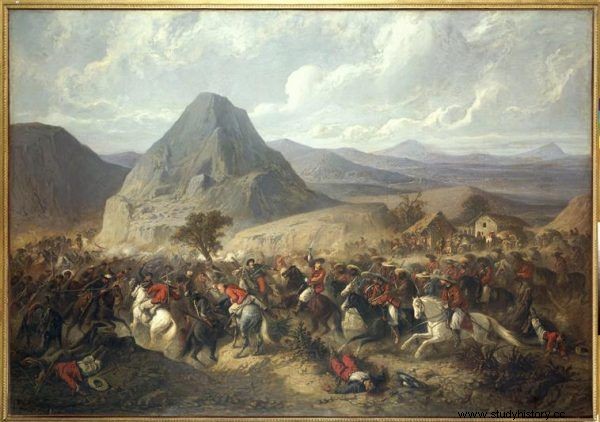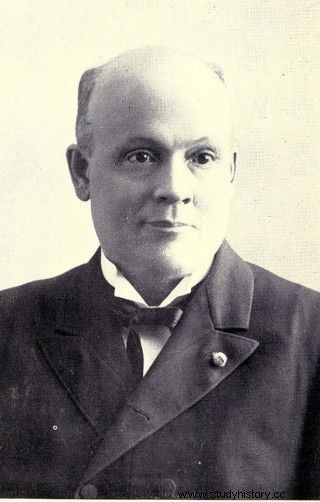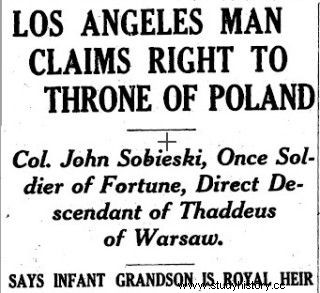As a US soldier, John Sobieski participated in 42 battles, participated in the execution of the Mexican emperor, fought for women's rights and was one of the founders of the Prohibitionist Party. In his lifetime he led journalists by the nose and professional historians after his death.
Blagier, cocky and a bit of an adventurer - wrote historian Tadeusz Łepkowski about him. He was certainly a bluffier. If you read Sobieski's story about his childhood in Europe and use the poker "check", his account crumbles like a house of cards. It can even be broken down into dialogue.
Jan Sobieski: I am a direct descendant of King Jan III Sobieski.
Historical Trivia: You're not, the last male descendant of the king died in 1737.
JS: My father, Jan Sobieski, graduated from Heidelberg in 1840, in 1846 he was arrested by the Russians, imprisoned in terrible conditions and executed.
CH: There is no Sobieski on the student enrollment of Heidelberg who would graduate in 1840, or even a decade earlier or later.

John Sobieski could not have been a descendant of Jan III Sobieski ...
JS: My mother, Izabela from Bemów, was the sister of General Józef Bem. My grandfather Bem and my mother's brothers were executed by the Russians.
CH: There is no such sister in any of Bem's biography or genealogies. In 1846, Aleksander Bem, Józef's half-brother, was arrested, but ended in exile.
JS: The Tsar's brother told my mother that if he raised me in Orthodoxy, he would not take her property. Mom refused, our property was taken and expelled from the country.
CH: Okay, in 1848 one brother of the tsar, Michał Pawłowicz, lived in the Kingdom of Poland.
JS: We were expelled from Austria and Prussia, my mother worked as a teacher in Bern, and later in Milan, from where we were expelled by order of the viceroy Maximilian Habsburg. Then we lived in England. When my mother fell ill, Zolaska's family took me in.
CH: Are Zolaski the Żuławskis? They went through England to the United States.
JS: I also met Lajos Kossuth, leader of the Hungarian Uprising of 1848.
CH: It has arms and legs, because Mrs Żuławska was the sister of Lajos Kossuth.
JS: After my mother died, I was taken in by Professor Kolaski from Liverpool.
CH: You're making something up. Sources do not know such a man.
JS: I was 12 and an orphan. Alone in the world, without family, friends and money. In 1854 I came stowaways to America on the "Constellation".
CH: Indeed, in 1854 a ship with that name made a voyage on the Liverpool - USA line.
After reading Sobieski's diaries, one gets the impression that they are confabulations of a poor orphan. Maybe he once met the Żuławskis, Kossuth's nephews, which would translate the surname "Zolaski" and make himself an uncle out of another hero of the Hungarian Spring of Nations - Józef Bem.

Sobieski was not the nephew of Józef Bem, the hero of the Hungarian uprising (the picture shows the capture of the castle in Buda by the Hungarians in 1849).
Sobieski even made a name for himself, because he was performing as "Seboski" for half his life which sounds like a corrupt form of the name Zęboski or Zębowski. As Seboski, he appears both in official documents and in his daughter's baptism certificate.
Love and death, Mormons and Apaches
Seboski at the age of 13 landed in the barracks, at the age of 15 he made his first military campaign (against the Mormons in Utah who opposed the ban on polygamy), and as a 16-year-old he would fight Apaches.
His branch was stationed at Fort Utah, New Mexico. It was necessary to bring in from a neighboring fort some 20 miles away, a young Spanish woman whose father was supplying equipment for the army. A 16-year-old musician, as Sobieski described him, probably himself volunteered.
On the way, the young people found a common language, although they both did not know English well. The story of Sobieski's first love had comedy (angry father of a Spanish woman) and dramatic elements. A year later, while passing through New Mexico, our hero found the decomposing corpse of his beloved and her father, murdered by the Indians.
In the Civil War
Sobieski spent the entire Civil War in the ranks of the North. At Gettysburg, the bloodiest battle of the conflict, he was shot in the stomach. He was convinced he had thirty minutes to live. After twenty, he was lifted on a stretcher from the battlefield. The doctor had no illusions about the patient's condition.
- If you do not live in harmony with God, you better be reconciled, because you have little life left.

The bloodiest battle of the Civil War could have ended tragically for Sobieski as well ... (lithograph by Thure de Thulstrup, renovation by Adam Cuerden).
The young soldier, however, recovered, returned to the army, and took part in more than one battle. On June 26, 1865, he left the United States Army. He was 23 years old, and in his own words - 10 years of service, 42 battles and 426 fire exchanges. It got quiet in the United States, so he headed for where it had always been restless. To Mexico.
Against the Mexican Emperor
He visited there in October 1865. In Mexico, there was a civil war between Emperor Maximilian Habsburg, backed by the French, and Republicans backed by the United States. The Republican army was a real mix of nationality and religion. Americans, English, Irish, Germans - indeed, even Mexicans served there. The conflict was bloody, no prisoners were taken.
Seboski was very lucky again. He took part in a night attack on a group of about 30 French who hid in a reed factory. On the spot, the republicans were welcomed by over 500 soldiers with shots! Seboski hid in the rubble, several dozen French passed him and then fled to his camp. It turned out that he was the only survivor of his squad.
In addition, the Pole found himself in Queretaro, where Emperor Maximilian was shot. After the firing squad, it turned out that the wounded emperor was writhing in torment. The platoon leader ordered one of his men to shoot the condemned man, but Seboski interfered with everything. In the firing squad, one of the soldiers always had a blank cartridge, so just in case the Pole offered his revolver.

Sobieski certainly did not make it to the battle of Hierba-Buena (June 8, 1865).
And so Maximilian Habsburg, Emperor of Mexico, died with the arms of Colonel Jan Sobieski . Doesn't it sound good?
Heir to the Polish crown
These Mexican stories were probably made up. According to his own account, Seboski stayed for a few more months in Mexico and in September 1867 he came to New York. He did some sightseeing in the United States, became involved with freemasons, and was elected to the Minnesota House of Representatives in January 1868.

John Sobieski - an inconspicuous master of self-creation.
Official documents correct these dates:1865 - settling in Minnesota, 1866 - election won, January 1867 - beginning of office. There is no room for Mexico. In fact, it is only from 1868 that the fate of Seboski - that is, Sobieski, as he later signed - becomes fully verifiable.
Our hero joined the Masonic organization Good Templars . He advocated the equality of women, the abolition of the death penalty and prohibition. He traveled around the United States with lectures, ran a law firm, ran unsuccessfully in various elections, even to the US Congress in 1886.
With time, he changed his name to Sobieski and began to talk about his royal roots. American journalists picked up on the topic. In 1905, the "Los Angeles Herald" reported from Chicago about the celebration of the 50th anniversary of the arrival to the States of John Sobieski, "great-grandson of Jan Sobieski, the last king of Poland."
In 1907, "True Republican" titled an article about Seboski: "A man from Los Angeles has the rights to the Polish throne" . By the way, the journalist calls him a descendant of Tadeusz from Warsaw, confusing Sobieski with Kościuszko. You can count on poor and unreliable journalists at any time.

John Sobieski's family, from the left:daughter Mary, wife Lydia Gertrude nee Lemen, son John
In 1901, John Sobieski settled in Los Angeles. In 1915 he published a biography of Jan III Sobieski. He died on November 12, 1927. His son, John, called by his father the last of the royal Sobieski line, lived only thirteen years.

A man from Los Angeles has the rights to the Polish throne
Mary's daughter married a banker named Gilhousen. This new line of the Sobieski family has survived. Her son, John Gilhousen, took the surname Sobieski. John G. Sobieski, a Stanford graduate, was a lawyer who served in the US Navy during World War II and Korea. He died in 1987. His descendants still live in California today.
***
When I started my article about John Sobieski, I thought that it would be another adventurer with Polish roots who had various adventures in exotic countries. Meanwhile, it turned out that he was a great master of self-creation, who led journalists by the nose during his lifetime, and professional historians after the death.
